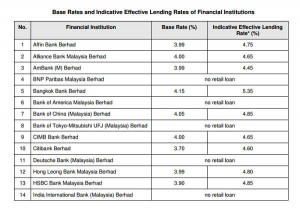New Reference Rate Framework – Effective 02 Jan 2015
 Effective 2 Jan 2015, the Base Rate will replace the Base Lending Rate (BLR) as the main reference rate for new retail floating rate loans.
Effective 2 Jan 2015, the Base Rate will replace the Base Lending Rate (BLR) as the main reference rate for new retail floating rate loans.
Since the introduction of the BLR framework in 1983, the BLR has served as the main reference rate on retail floating rate loans in Malaysia. Since then, the determination and implementation of the BLR has evolved with the development of the financial sector. In the recent period, however, the BLR has become less relevant as a reference rate for loan pricing, as lending rates on new retail loans are being offered at substantial discounts to the BLR. The BLR also lacks transparency, which makes it difficult for consumers to make an informed decision.
The new Reference Rate Framework aims to provide a more transparent reference rate to enable better decision by consumers in making choices among the many loan products offered by financial institutions. The new reference rate will also better reflect changes in cost arising from monetary policy and market funding conditions, while encouraging greater discipline and efficiency among financial institutions in the pricing of retail financing products.
The Base Rate will be determined by the financial institutions’ benchmark cost of funds and the Statutory Reserve Requirement (SRR). Other components of loan pricing such as borrower credit risk, liquidity risk premium, operating costs and profit margin will be reflected in a spread above the Base Rate. This increases the visibility of the factors underlying changes to the Base Rate. The greater transparency in turn will enable more informed decision making by consumers. Under this cost-plus structure, spreads will always be positive as it would not be possible for financial institutions to offer lending rates below the reference rate. Financial institutions will be given the flexibility to determine their respective benchmark rates. The expected strong link between the Base Rate, market interest rates and the Overnight Policy Rate (OPR) will facilitate more complete adjustments to retail loan repayments when market interest rates adjust to an increase or decrease in the OPR.
The Base Rate will be used for new retail floating rate loans and the refinancing of existing loans extended from 2 January 2015 onwards. After the effective date, BLR-based loans prior to 2015 will continue to be referenced against the BLR. However, when a financial institution makes any adjustments to the Base Rate, a corresponding adjustment to the BLR will also be made. As such, financial institutions would be required to display both their Base Rate and BLR at all branches and websites.
The shift to the new Reference Rate Framework should have no impact on the effective lending rates charged to retail borrowers which are determined by various factors, including a financial institution’s assessment of a borrower’s credit standing, market funding rates and competitive considerations. It is also important to note that the changes do not represent a change in the Bank’s monetary policy stance.
The following is the Base Rates and Indicative Effective Lending Rates of Financial Institutions as at 2 January 2015:
Base Rate and Indicative Effective Lending Rates as at 02/01/2015 (PDF, 29KB)
Source: Bank Negara Malaysia

